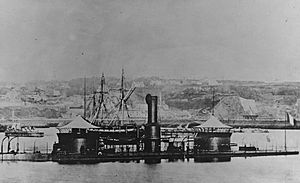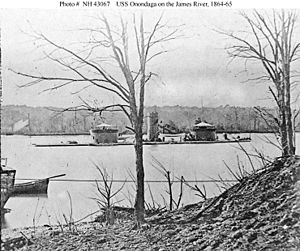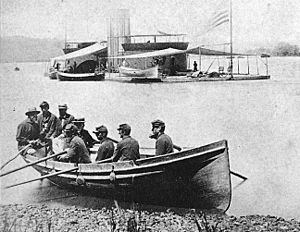USS Onondaga (1863) facts for kids

Onondaga at anchor on the James River, c. 1864–1865
|
|
Quick facts for kids History |
|
|---|---|
| Name | Onondaga |
| Namesake | A lake and county in New York |
| Ordered | 26 May 1862 |
| Builder | Continental Iron Works, Greenpoint, Brooklyn |
| Laid down | 1862 |
| Launched | 29 July 1863 |
| Sponsored by | Sally Sedgwick |
| Commissioned | 24 March 1864 |
| Decommissioned | 8 June 1865 |
| Fate | Sold to her builder, 7 March 1867, and subsequently resold to France |
| Name | Onondaga |
| Acquired | 7 March 1867 |
| Stricken | 2 December 1904 |
| Fate | Sold for scrap, 1904 |
| General characteristics (as built) | |
| Type | Double-turreted river monitor |
| Tonnage | 1,250 tons (bm) |
| Displacement | 2,592 long tons (2,634 t) |
| Length | 226 ft (68.9 m) (o/a) |
| Beam | 51 ft 5 in (15.7 m) |
| Draft | 12 ft (3.7 m) |
| Depth | 12 ft 10 in (3.9 m) |
| Installed power |
|
| Propulsion | 2 × propellers; 2 × back-acting steam engines |
| Speed | 7 knots (13 km/h; 8.1 mph) |
| Range | 720 nmi (1,330 km; 830 mi) |
| Complement | 130 officers and enlisted men |
| Armament |
|
| Armor |
|
The USS Onondaga was a special type of warship called an ironclad river monitor. It was built for the Union Navy during the American Civil War. An ironclad is a ship covered in thick metal armor, making it very strong against enemy fire.
Onondaga was launched in 1863 and started service in 1864. It spent its entire time in the U.S. Navy on the James River in Virginia. Its main job was to protect the water routes leading to Richmond, Virginia, which was the capital of the Confederate States of America.
After the war, the ship was bought by France. It then served in the French Navy as a coastal defense ship. Onondaga didn't see much action with the French. It spent most of its time in a reserve fleet, meaning it was kept ready but not actively used. It was briefly called into service during the Franco-Prussian War in 1870–1871.
Later, in 1898, it became a guard ship. This means it was used to protect a port or area. Finally, in 1904, Onondaga was removed from the navy's list and sold for scrap. It was taken apart in 1905.
Contents
Ship Design and Features
Onondaga was 226 feet (68.9 m) long and 51 feet 5 inches (15.7 m) wide. It was heavier than planned, which made it sit lower in the water. The ship had a crew of 130 sailors and officers.
How Onondaga Moved
The ship was powered by two large steam engines. These engines turned two 10-foot (3 m) propellers. Steam for the engines came from four tall water-tube boilers. The engines gave the ship a speed of 7 knots (13 km/h; 8.1 mph), which is about 8 miles per hour (13 km/h). It could travel about 720 nautical miles (1,330 km; 830 mi) (about 828 miles (1,333 km)) on one load of coal. Iron rings were placed around the propellers to protect them from things underwater.
Powerful Guns
Onondaga's main weapons were four large guns. It had two 15-inch (381 mm) Dahlgren guns and two 150-pounder (8-inch (203 mm)) Parrott rifles. These guns were placed in two large, spinning gun turrets. Each turret had one Dahlgren gun and one Parrott rifle.
The ship's pilothouse, where the captain steered, was built on top of the front turret. Small steam engines helped to spin the heavy turrets. The Dahlgren guns were very heavy and could fire a 350-pound (159 kg) shell up to 1,700 yards (1,600 m) away. The Parrott rifles fired 155-pound (70 kg) shells up to 2,100 yards (1,900 m).
Strong Armor Protection
Onondaga was an ironclad, so it had strong armor. The sides of the hull were covered with 4.5-inch-thick (110 mm) wrought-iron plates. To make it even stronger, 12 inches (305 mm) of wood was added behind the armor, covered by another 1-inch (25 mm) iron plate. This extra wood made the ship sit deeper in the water than planned.
The gun turrets and the pilothouse were protected by 11 inches (279 mm) of armor. A thick iron band was placed around the bottom of the turrets. This was to stop enemy shells from jamming the turrets, which had happened to other ships. The ship's deck was also protected by two layers of one-inch thick plates. Even the base of the smokestack was armored.
Building and Service
The U.S. Navy wanted a twin-turret ironclad for harbor and coastal defense. They ordered Onondaga in May 1862. The ship's engines were built by Morgan Iron Works, and the rest of the ship was built by Continental Iron Works in Greenpoint, Brooklyn.
Onondaga was the first U.S. Navy ship to be named after the lake and county in New York. It was launched on July 29, 1863. Sally Sedgwick, whose father was a U.S. Representative, was the ship's sponsor.
The ship was officially put into service on March 24, 1864, at the New York Navy Yard. Its construction was delayed because of a lack of materials and workers. The shipyard even closed for a while during the New York City draft riots in July 1863.
Onondaga left New York City on April 21, 1864. It arrived at Hampton Roads in Virginia two days later. It was assigned to the James River Flotilla. This group of ships supported General Ulysses S. Grant's push towards Richmond, Virginia. Onondaga patrolled the river and sometimes fired at Confederate artillery batteries on the riverbanks.
The Battle of Trent's Reach
In January 1865, most of the Union ironclads were sent away from the James River. This was because Rear Admiral David Dixon Porter was gathering ships for an attack on Fort Fisher, North Carolina. Onondaga was the only ironclad left to protect the Union forces along the James River from the Confederate James River Squadron.
When the Confederate squadron came down the river to attack, Onondaga moved to a better position. It waited with its supporting gunboats. However, the Confederate attack was stopped when some of their ships ran aground as the tide went out. These ships included the ironclads Virginia II and Richmond.
As the Confederate ships were being refloated, Onondaga moved closer and opened fire. Its Dahlgren guns hit Virginia II twice. One shot went through its armor and caused a lot of damage. The second shot killed one crewman and injured two others. Richmond was hit by a glancing shot that damaged its gun port. After these hits, the Confederate ships pulled back upriver.
The commander of Onondaga, William Parker, was later put on trial for not fighting the Confederate ironclads more directly. However, the Secretary of the Navy, Gideon Welles, canceled the guilty verdict.
Onondaga continued to support Union troops until the war ended on April 9, 1865. The ship then sailed north and was taken out of service in New York City on June 8. It was later sold back to its builder, who then sold it to France.

Onondaga kept its name when it joined the French Navy. It was towed from New York City to Halifax in September 1867. Then, it was towed across the Atlantic to Brest, arriving in July 1868.
After arriving, the ship went through a major refit. Its original guns were replaced with four new French rifled breech-loading guns. Other changes included adding teak wood behind the armor on its sides and probably removing the rings around its propellers.
Onondaga started its sea trials in May 1869 and was then placed in reserve. It was called into service on July 17, 1870, during the Franco-Prussian War, but it did not see any combat.
In 1878, more weapons were added, including six Hotchkiss 5-barreled revolving cannon and some torpedoes. In April 1898, it became a guard ship at Saint-Malo. Its smaller guns were replaced with a dozen Hotchkiss guns of different sizes.
Onondaga was removed from the French Navy's list on December 2, 1904. It was sold for scrap and taken apart in Brest in 1905.



